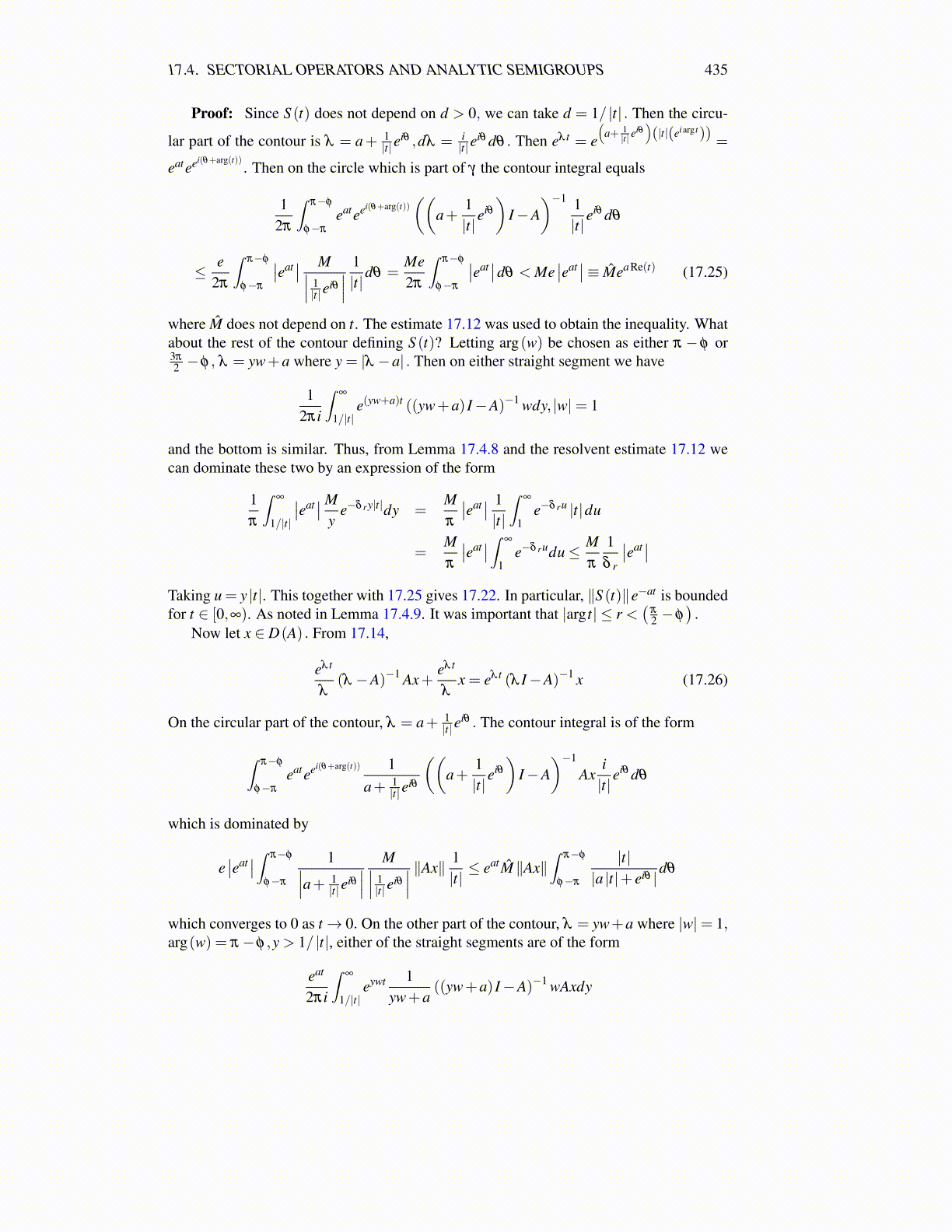
17.4. SECTORIAL OPERATORS AND ANALYTIC SEMIGROUPS 435
Proof: Since S (t) does not depend on d > 0, we can take d = 1/ |t| . Then the circu-
lar part of the contour is λ = a+ 1|t|e
iθ ,dλ = i|t|e
iθ dθ . Then eλ t = e(
a+ 1|t| e
iθ)(|t|(eiarg t))
=
eateei(θ+arg(t)). Then on the circle which is part of γ the contour integral equals
12π
∫π−φ
φ−π
eateei(θ+arg(t))((
a+1|t|
eiθ)
I−A)−1 1|t|
eiθ dθ
≤ e2π
∫π−φ
φ−π
∣∣eat ∣∣ M∣∣∣ 1|t|e
iθ∣∣∣ 1|t|
dθ =Me2π
∫π−φ
φ−π
∣∣eat ∣∣dθ < Me∣∣eat ∣∣≡ M̂eaRe(t) (17.25)
where M̂ does not depend on t. The estimate 17.12 was used to obtain the inequality. Whatabout the rest of the contour defining S (t)? Letting arg(w) be chosen as either π − φ or3π
2 −φ , λ = yw+a where y = |λ −a| . Then on either straight segment we have
12πi
∫∞
1/|t|e(yw+a)t ((yw+a) I−A)−1 wdy, |w|= 1
and the bottom is similar. Thus, from Lemma 17.4.8 and the resolvent estimate 17.12 wecan dominate these two by an expression of the form
1π
∫∞
1/|t|
∣∣eat ∣∣My
e−δ ry|t|dy =Mπ
∣∣eat ∣∣ 1|t|
∫∞
1e−δ ru |t|du
=Mπ
∣∣eat ∣∣∫ ∞
1e−δ rudu≤ M
π
1δ r
∣∣eat ∣∣Taking u = y |t|. This together with 17.25 gives 17.22. In particular, ∥S (t)∥e−at is boundedfor t ∈ [0,∞). As noted in Lemma 17.4.9. It was important that |arg t| ≤ r <
(π
2 −φ).
Now let x ∈ D(A) . From 17.14,
eλ t
λ(λ −A)−1 Ax+
eλ t
λx = eλ t (λ I−A)−1 x (17.26)
On the circular part of the contour, λ = a+ 1|t|e
iθ . The contour integral is of the form
∫π−φ
φ−π
eateei(θ+arg(t)) 1a+ 1
|t|eiθ
((a+
1|t|
eiθ)
I−A)−1
Axi|t|
eiθ dθ
which is dominated by
e∣∣eat ∣∣∫ π−φ
φ−π
1∣∣∣a+ 1|t|e
iθ∣∣∣ M∣∣∣ 1|t|e
iθ∣∣∣ ∥Ax∥ 1
|t|≤ eatM̂ ∥Ax∥
∫π−φ
φ−π
|t||a |t|+ eiθ |
dθ
which converges to 0 as t→ 0. On the other part of the contour, λ = yw+a where |w|= 1,arg(w) = π−φ ,y > 1/ |t|, either of the straight segments are of the form
eat
2πi
∫∞
1/|t|eywt 1
yw+a((yw+a) I−A)−1 wAxdy